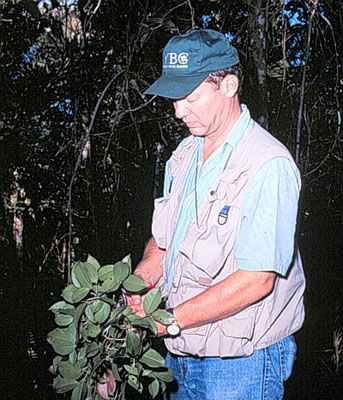Plant Collecting
in the Coastal Forest
 In
order to document a tropical forest flora, each species in the flora must
be documented through collection. Because the flowers or fruits of
many species (especially trees, lianas, and epiphytes) are difficult to
see and reach, collecting in tropical forests is a difficult and time consuming
activity. Many tree species are widely dispersed (e.g., one individual
per hectare) and their flowering period is brief. This necessitates
repeated visits to document the flora.
In
order to document a tropical forest flora, each species in the flora must
be documented through collection. Because the flowers or fruits of
many species (especially trees, lianas, and epiphytes) are difficult to
see and reach, collecting in tropical forests is a difficult and time consuming
activity. Many tree species are widely dispersed (e.g., one individual
per hectare) and their flowering period is brief. This necessitates
repeated visits to document the flora.
To select collecting sites, we use all available information,
including maps and satellite images, to analyze elevation, soil type, and
vegetation type. Geographical coordinates of collecting sites are determined
as precisely as possible using GPS devices (if readings underneath the
forest canopy are not possible, readings are taken from a clearing near
the forested collection site).
At each site, we search for species in flower or fruit.
These are collected unless we are sure that they have been previously collected
(this minimizes the repeated collection of common or weedy species).
Fertile plants are sought by walking through each site and searching on
the ground for fallen flowers or fruits or using binoculars to find those
remaining in the trees. In cases where trees, lianas, or epiphytes
cannot be collected from the ground (aluminum pole
pruners can be used to collect material up to ca. 10 m above the ground),
trees are climbed. Specimens are pressed in the field, numbered, catalogued,
and dried at preparation facilities. Collection and specimen drying
is done to maximize the preservation of DNA material for possible analysis.
Flowers are often preserved in FAA or ETOH when appropriate. Photographs
are taken to document plant features not easily preserved through standard
collecting and drying.
 |
Specimens usually are collected in sets of four to eight
duplicates. Half of the duplicates of any collection and any unicates
remain in Brazil (at CEPEC) as dictated by Brazilian law and are distributed
to specialists and interested herbaria within Brazil. The remaining
specimens are sent to NY for distribution to the international botanical
community. At NY, the best sheet is mounted for the NY collection
and the second is sent to the appropriate specialist (the current NY specialist
list includes 185 botanists identifying material in 180 families of plants)
for identification. For groups in which no specialist exists or for
which identifications are not returned in a timely manner, material is
identified by project staff. Once a collection is identified, duplicates
are distributed to herbaria whose acquisition policies emphasize the flora
of tropical Brazil or the taxonomic group of the specimen. |
Contact Us | ©2005 Wm. Wayt Thomas, The New York Botanical Garden
 In
order to document a tropical forest flora, each species in the flora must
be documented through collection. Because the flowers or fruits of
many species (especially trees, lianas, and epiphytes) are difficult to
see and reach, collecting in tropical forests is a difficult and time consuming
activity. Many tree species are widely dispersed (e.g., one individual
per hectare) and their flowering period is brief. This necessitates
repeated visits to document the flora.
In
order to document a tropical forest flora, each species in the flora must
be documented through collection. Because the flowers or fruits of
many species (especially trees, lianas, and epiphytes) are difficult to
see and reach, collecting in tropical forests is a difficult and time consuming
activity. Many tree species are widely dispersed (e.g., one individual
per hectare) and their flowering period is brief. This necessitates
repeated visits to document the flora.
